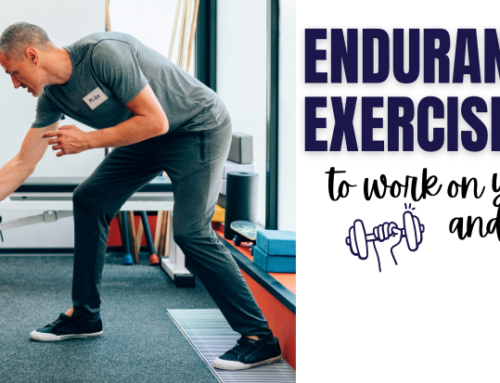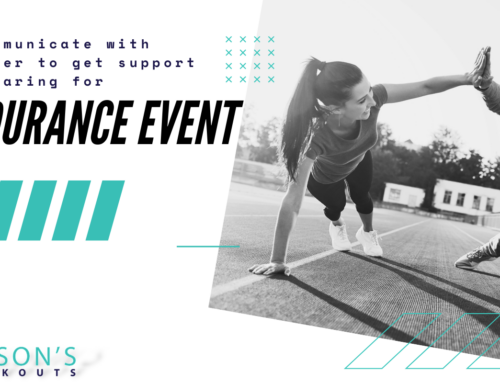As some of you may know, I am going to be running the Boston marathon (read here for more information). As a Personal Trainer I know the importance of training and having a plan to run it. The psychology is also part of the preparation. I am fortunate to be friends with a Sports Psychologist, Suzannah, who offered to give me a session on imagery. You can see the video here and below the video there is a transcript. But the video works the best!
L: Hi, I’m Lorna and I am here from Wilson’s Workouts. Today I am with Suzannah who is a sports psychologist. Hi Suzannah.
S: Hey.
L: Can you tell a bit about what you do and what type of people you work with?
S: Yeah, so I am a sports psychologist and basically what I focus on is the mental part of training and performance. So just like every athlete does some physical preparation, strength training, conditional training, there is also a mental aspect to performance and that’s what I focus on with the athletes that I work with. Mainly I work with really enthusiastic amateur athletes but also with professionals.
L: That’s cool. Okay, so the reason why I have asked Suzannah to come today is because I have a big challenge coming up. I am going to be running the Boston Marathon is April and I’m training in Amsterdam where it’s really flat and at mile 20 of the Boston Marathon, which is about 32km in, there is a bit of a hill called Heartbreak Hill and I want to make sure I am really prepared for when that time comes. The point of 20 miles in a marathon is when it gets really tough so to add a hill in, I think’s a bit evil but… So, Suzannah’s going to help with some imagery, not specifically for the hill but just to understand what imagery is and how to use it. Is that correct?
S: Yep, exactly.
L: Okay, so over to you.
S: Yep. So, imagery is a mental skill that you can use to prepare for some part of your race, prepare for any part of performance, but it is a skill and therefore it’s good to practice it a little bit before you can actually use it. Just like if you want to do a squat or whatever, you have to also know the technique before you can perform it perfectly. So, we are going to introduce imagery with 3 short exercises and Lorna will be trying them out and I will be guiding you through the exercises. Please join us while you are watching the video.
L: Thanks Suzannah.
S: There are three important aspects of imagery that you have to be able to control to do imagery correctly. The first is the perspective from which you are looking. So, are you looking through your own eyes or are you looking at yourself from a distance or from the side? The second is detail. So, how much detail do you see in your mind’s eye. Can you picture sounds and smells, but also do you remember exactly what things look like? And the final aspect is control. So, are you able to steer what you see? And this is really important because in imagery we always try to visualise the idea situation. You can probably already imagine now that it’s really easy to picture what goes wrong, but to be able to use imagery to practice, it’s good to visualise the perfect situation and that’s why control is the third aspect that we are going to work on today. So, let’s go straight in to the first exercise.
L: Okay, curious.
S: Perspective.
L: Yep. Okay.
S: Alright. So, I would like to you close your eyes and imagine that you are doing your running workout.
L: Okay.
S: And what kind of terrain do you usually train in?
L: Mostly on the kind of road surfaces and a little bit in the forest.
S: Okay. So, let’s take road surface, because that’s where you train usually and also that Boston Marathon is on road surface.
L: Yep.
S: Okay. So, I want you to picture yourself running.
L: Okay.
S: What perspective are you seeing now?
L: Where I’m…as if it’s me and I’m just…what’s in front of me.
S: Okay, so can you see the rest of your body if you were to look down?
L: Yeah.
S: Okay.
L: If I look down I can see my legs moving.
S: Okay. And when you look up, you see…what do you see there?
L: I see the road in front of me and trees down the side.
S: Okay. So, keep imaging this perspective, but now we are also going to do a little bit of a controlled exercise within this one.
L: Okay.
S: I want you to imagine that you are seeing yourself from behind. So, as if you are walking behind Lorna.
L: Okay.
S: And try to picture yourself in your running place, on a road.
L: Okay, yeah.
S: Can you see yourself running?
L: It’s kind of strange but yes.
S: Okay, and now move from behind you to next to you, as if you are running beside Lorna.
L: Okay, yeah.
S: Okay, how does that feel?
L: It feels unusual but yeah.
S: Can you picture yourself?
L: Yeah, I can, yeah, it’s not easy but I can.
S: What makes it difficult?
L: Because I am so used to imaging me being me and not…yeah, just because it’s different I guess.
S:Okay, so now you are running beside yourself.
L: Yep.
S: And now I want you to take a bird’s eye view. So, you zoom out and now you can see yourself running from above, but you can also see a lot more of the surroundings. So, imagine a part of road that you run on quite often. So besides yourself you can also see some of the details.
L: Okay yeah.
S: Are you there?
L: Yeah.
S: Okay. So now I want you to zoom back to the first focus you had, your personal view and step out when you are ready.
L: Okay yep, so I can open my eyes now?
S: Yep, okay. So, that was the first exercise.
L: Okay.
S: Dealing with different perspectives. Can you tell me which one you preferred?
L: I still preferred the first one, yeah.
S: Okay. Can you imagine a situation where you might use one of the others?
L: I guess when it’s harder, because you are, kind of, perhaps removing yourself from yourself.
S: Yeah.
L: Is that right, yeah?
S: Yeah definitely. Yeah.
L: Okay.
S: So, this is an important exercise, because we’ve tried a couple of different perspectives, so we know now when you’re going to practice your real imagery for the Boston Marathon, it’s important for you to use your personal perspective.
L: Okay, yeah.
S: Okay. So, if you’ve tried the exercise yourself at home, make a note of what perspectives you have found comfortable and if you might be able to use a different perspective in a different situation. But make note, especially of the one that you find most comfortable, because that’s the perspective you are going to use for your mental training.
L: Thank you.
S: Alright?
L: Yep.
S: Now we are going to go to detail.
L: Okay.
S: And for that we need an object. Let’s take this pen. Nothing special about a pen but it’s just…
L: Okay, yeah.
S: So, I would like to give a couple of seconds to look at the pen. Feel it.
L: Okay.
S: And try to remember everything about this object.
L: Okay.
S: I will give you a couple of seconds for that.
L: Okay.
S: Okay?
L: Yeah.
S: You think you know everything about the pen now?
L: I hope so.
S: Right. Hand it back to me and you can close your eyes.
L: Okay.
S: Alright, so, imagine the pen you were just holding. Can you remember what colours it has?
L: So, it’s blue and see-through with a dark ink and metallic nib of the pen.
S: Can you remember what colour the ink is?
L: It’s very dark blue.
S: And do you know what colour the tip is?
L: I think blue with ink or silver with the metal.
S: Okay. What else do you remember about the shape of the pen?
L: It’s cylindrical but it goes to a point at the end. And there’s a, I don’t know what you would call it, so you can hook it on something.
S: Yeah.
L: So, that sticks out. And there’s a little button on it so that you can turn it off, which would be a sort of square or cube sort of. And then at the end, towards the nib of the pen there’s like a, what would you call it, ridged?
S: There’s texture.
L: Yeah. That’s all I can think of.
S: Okay. Is there any other textures on the pen beside the ridges?
L: Well it’s smooth where it’s blue and there there’s like a line where the two plastics join and also, it’s a little bit rough where there’s text written on it, a little man on it. Yep.
S: Do you know what the text is?
L: B-I-C, Bic.
S: Yep exactly. And you said that there’s also a little man as well.
L: Yep.
S: Was that the logo?
L: I guess so yeah.
S: Yeah, okay. How heavy is the pen?
L: Very light.
S: Can you imagine holding the pen, how heavy it is?
L: Yeah, I think so, yeah.
S: You said you already mentioned about the material it’s made of. Can you describe the material a bit more to me?
L: Well it’s plastic and it’s very smooth and I can’t think of anything more.
S: Is it hard or soft?
L: It’s hard yeah.
S: Yeah. It’s a hard plastic?
L: Yep.
S: Alright. And was the pen on or off when you held it?
L: It was on.
S: Alright, you can open your eyes.
L: Okay.
S: I am going to hand the pen back to you and I want you to look at it again and see if there is anything that your remembered different.
L: Okay, so this was more of a gold colour than silver.
S: Yep.
L: And…this looks more black than navy doesn’t it, I think.
S: Yeah.
L: And this is not so much as a square as a curve.
S: Yeah.
L: So, a few things.
S: Yep there were quite a few things. So, this is very typical of focusing on detail.
L: Okay, yeah.
S: So, if you are going to use imagery in your training, it’s important to be as detailed as possible. This is so that you know exactly what to expect. How of course a pen isn’t so exciting, but you can imagine if you are training for a marathon, it’s important to really know what to expect in terms of how crowded it will be, what kind of scenery you will be coming across, transitioning from one part of the race to the next and this is important if you can really imagine the details, they you can keep yourself calm because you just know what’s coming.
L: Thanks.
S: So, this is a good exercise to work on detail. So, if you notice that it’s difficult to think of details while you are doing your imagery training, you can do small exercises like this one.
L: With another object, yeah.
S: Just to train your brain. Alright.
L: Thank you.
S: The final exercise is control.
L: Okay.
S: So, I would like to ask you to close your eyes again.
L: Okay.
S: And imagine your front door.
L: Downstairs?
S: Yes.
L: Okay, yeah.
S: Okay so can you see your front door?
L: Yeah.
S: And how far away are you standing?
L: About half a meter.
S: I want you to go a little bit further back so like, maybe to the other side of the street and look at your house.
L: Okay, yeah.
S: Okay, so this exercise is about control and it’s, I think, the funkiest exercise of all. I would like to ask you to imagine your house with your front door but now the door stays the same but the house size doubles. So, imagine everything else is still…the front door is the normal size and everything else is twice as large. Can you do that?
L: Yeah, I can, yeah.
S: And not like you are looking through a magnifying glass, so objects that are standing in front of your door, like for instance plants or the street tiles are the same but the house is suddenly twice as large.
L: Okay, yeah.
S: Are you there?
L: Yep.
S: Now go back to normal size. Imagine your front door as it is.
L: Okay.
S: Alright, not we are going to shrink everything besides the front door.
L: Okay.
S: So, imagine your house looks teeny tiny. And it all still looks to a certain degree normal but it’s just smaller.
L: Okay, yeah.
S: Right. Objects in front of your house are also the same size as they normally are. Only the house itself is half the size it should be.
L: Okay.
S: Alright. How does that look to you?
L: Very strange.
S: Alright and now go back to normal size.
L: Okay, yeah.
S: And you are still standing on the other side of the street.
L: Okay.
S: And you can open your eyes.
L: Okay.
S: Alright, so that’s a really short exercise about controlling what you see.
L: Okay.
S: And it starts with a task, so shrink or double the size of your house and then it’s up to your mind’s eye to do that.
L: Okay.
S: Okay, so this exercise is really important to be able to steer what you are going to practice. If you want to have a successful experience in performance, it’s important to already have experience of that performance in your imagery, so that’s why we do exercises on control.
L: Okay. Thank you very much.
S: You’re very welcome.
L: And thank you for your time today and we’re going to put the website line to Suzannah’s business which is called?
S: De Prestatiekwekerij which is the Dutch name.
L: Yeah, which I can’t pronounce. We’ll put that as a link with the video so that you can go look at what she does. So, thank you very much.
S: Thank you.
L: Okay.
Author: Lorna Wilson
Like what you see? Then send me a message or e-mail. We can meet up for a chat and find out how I can help you improve your training and help reduce injury risk.
06 460 377 74 / lorna@wilsonsworkouts.nl





[…] having made a video of my session with a Sports Psychologist I thought it would also be interesting to interview my triathlon coach Matt Warnock to share the […]